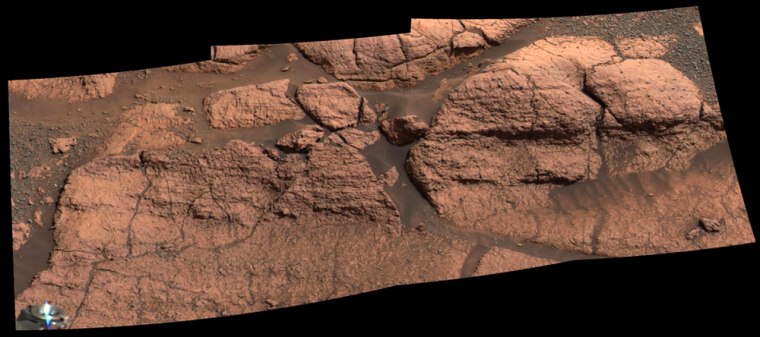The apparent discovery of ancient salty bodies of water on Mars by NASA's Opportunity rover last year is viewed as one of the most significant developments in planetary science.
But two new studies take a different view of the data.
Rather than abundant surface water over significant stretches of planet's history, as has been widely reported, Opportunity's observations might represent the results of a meteor impact or volcanic activity on an otherwise very dry world.
The counterarguments, presented in two papers in Thursday's issue of the journal Nature, go to the very heart of the ultimate question about Mars: Was it ever warm and wet enough to support life?
The new reports, however, are based on the initial data from the Opportunity rover during its first 45 days on Mars.
The Mars rover mission’s principal investigator, Steven Squyres of Cornell University, said both of the new studies could not take into account more recent data from Opportunity that were not available to the researchers.
Multiple explanations
At Meridiani Planum, Opportunity found photographic evidence of layered sandstone that, when analyzed by chemical sensors, looked as if it must have formed in the presence of significant amounts of water.
On Wednesday, Squyres told Space.com that his team's interpretation has always been that the water was mostly underground, sometimes seeping to the surface only to evaporate quickly. "From the start, the media has overemphasized surface water and underemphasized the underground water," he said.
In one of the new reports, scientists conclude the deposits could be nothing more than volcanic ash altered by very small amounts of acidic water and sulfur dioxide, which is a volcanic gas. The research was done by Thomas McCollom and Brian Hynek of the University of Colorado at Boulder.
"In our scenario, the water required to support the chemistry in this bedrock would only have had to have been around for months, years or perhaps as much as a few centuries," Hynek said Wednesday. "This is very different than previous scenarios, which require that a much larger amount of water be present for many millennia."
"This scenario does not require prolonged interaction with a standing body of surface water," McCollom and Hynek write in the Nature paper.
The Meridiani region was probably more like volcanic parts of Yellowstone, Hawaii or Italy than something like the Great Salt Lake, McCollom said. "We think it was far less favorable for past biological activity than other scenarios that have been proposed."
If McCollom and Hynek's scenario is correct, its effect would be in "greatly reducing the possibility that these rocks indicate that a habitable environment ever existed at Meridiani," according to Mark Bullock, a scientist at the Southwest Research Institute who was not involved in the studies.
Or it could be …
In the second paper, another group says an impacting space rock can explain the chemicals and layered deposits observed at Meridiani, as well as the famous BB-sized spheres dubbed blueberries.
In fact, Paul Knauth of Arizona State University and colleagues say, the blueberries are just too spherical and of uniform size to be explained by formation in water.
Knauth's team proposes that the meteorite generated a "ground-hugging turbulent flow of rock fragments, salts, sulfides, brines and ice," leaving deposits that were later weathered by small amounts of water embedded in the grains.
The scenario "can account for all of the features observed without invoking shallow seas, lakes or near-surface aquifers," the scientists contend.
There is little doubt that Mars, in its early history, experienced bouts of intense flooding that involved water. The evidence is plainly carved into the planet's surface in the form of canyons bigger than any on Earth. But Bullock said those early episodes could have involved very sudden and short-lived floods, spurred by ice melting in meteorite impacts that would have been frequent when the solar system was young.
"Both groups propose scenarios that preclude the existence of significant bodies of water at the surface (at least at Meridiani), and therefore that Mars may never have had conditions conducive to life," said Bullock, who wrote an analysis of the work for Nature. "This conclusion stands in sharp contrast to the provocative interpretations that there must have been long-lived surface water to form the Meridiani outcrops."
More Opportunity data
Squyres said a deeper understanding of the situation came when Opportunity examined Endurance Crater, where observations were made of 25 vertical feet of rock outcrops. Those results were published just a month ago, after the two Nature papers had been submitted.
Knauth, McCollom and Hynek "hadn't seen that stuff when they wrote their papers," Squyres said.
The nature of the layering and grain sizes deeper inside Endurance Crater "is absolutely incompatible with a volcanic or impact origin," Squyres said. It is "completely compatible" with the idea of windblown material, and the upper meter or so "shows evidence for deposition of water. The chemistry varies with depth in a way that requires that subsurface liquid water interacted with the rocks after they were deposited."
Squyres emphasized that his team has always thought the water was mostly underground, occasionally creating small surface lakes that evaporated quickly.
Squyres also stressed that nobody has done anything other than good science with the data available. "It's always good to have alternative hypotheses," he said. "In the end, the best ideas win. It forces everybody to go back and sharpen their arguments. All of this is a good thing."
It will take time for scientists to settle this important debate. The outcome could affect decisions about where to send future missions that would search for signs of life. Bullock called the investigation vital, "whatever the ultimate verdict proves to be."
